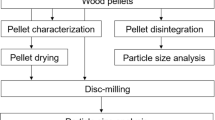Summary
Aspen wood was ball milled for times as long as 10 days. The change in wood morphology was examined in the ultraviolet microscope. The accessibility of the milled wood to cellulase was also determined. Soon after the commencement of the milling, part of the wood took on a characteristic appearance in which the cell wall material was completely broken down. The proportion of this disordered wall material (DWM) increased with increased time of milling. The accessibility to cellulase increased with the proportion of DWM produced by the milling.
Similar content being viewed by others
References
Desrochers, M.; Jurasek L.; Paice, M. G. 1981: High production of β-glucosidase in Schizophyllum commune: Isolation of the enzyme and effect of the culture filtrate on cellulose hydrolysis. Appl. Environ. Microbiol. 41: 222–228
Howsmon, J. A.; Marchessault, R. H. 1959: The ball-milling of cellulose fibers and recrystallization effects. J. Appl. Polym. Sci. 1: 313–322
Koshijima, T.; Taniguchi, T.; Tanaka, R. 1972: Lignin Carbohydrate Complex Pt. 1. The influence of milling of wood upon the Björkman LCC. Holzforschung 26: 211–217
Miller, G. L. 1959: Use of dinitrosalicylic acid reagent for determination of reducing sugars, Anal. Chem. 31: 426–428
Millett, M. A.; Effland, M. J.; Caulfield, D. F. 1979: Influence of fine grinding on the hydrolysis of cellulosic materials — acid vs. enzymatic. Adv. Chem. Ser. 181: 71–89
Musha, Y.; Goring, D. A. I. 1975: Cell dimensions and their relationship to the chemical nature of the lignin from the wood of broad leaved trees. Can. J. For. Res. 5: 259–268
Ruel, K.; Barnoud, F.; Eriksson, K.-E. 1981: Micromorphological and ultrastructural aspects of spruce wood degradation by wild-type Sporotrichum pulverulentum and its cellulaseless mutant Cel-44. Holzforschung 35: 157–171
Tanaka, R.; Yaku, F.; Murai, E.; Koshijima, T. 1980: Enzymatic degradation of finely divided wood meal of Pinus densiflora. Cellul. Chem. Technol. 14: 859–868
Whiting, P.; Goring, D. A. I. 1980: The morphological origin of milled wood lignin. Svensk Papperstidn. 84: R 120-R 122
Author information
Authors and Affiliations
Additional information
The authors wish to acknowledge the interest and valuable advice of Dr. B. A. Pethica throughout the conduct of this research
Rights and permissions
About this article
Cite this article
Fukazawa, K., Revol, J.F., Jurasek, L. et al. Relationship between ball milling and the susceptibility of wood to digestion by cellulase. Wood Sci. Technol. 16, 279–285 (1982). https://doi.org/10.1007/BF00353153
Received:
Issue Date:
DOI: https://doi.org/10.1007/BF00353153




